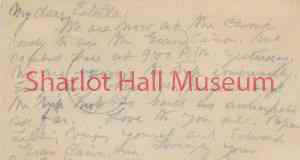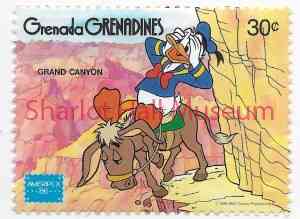By Marjory J. Sente
 The morning after her twelve or thirteen-hour stage ride to the Grand Canyon, Martha Burton Williamson wrote a penny postal card to her daughter Estella Williamson. The message was brief. “My Dear Estella, We are now at the camp ready to see the Grand Cañon. We arrived here at 9 P.M. yesterday. We are enjoying the trip immensely. Everything has been perfect and the trip not so hard as anticipated so far. Love to you all. Papa, Lillie, Virginia, yourself and Edward. Lovingly, Your Mama.” Martha added, “Grand Cañon, Ariz., June 9, ’95 Sunday A.M.”
The morning after her twelve or thirteen-hour stage ride to the Grand Canyon, Martha Burton Williamson wrote a penny postal card to her daughter Estella Williamson. The message was brief. “My Dear Estella, We are now at the camp ready to see the Grand Cañon. We arrived here at 9 P.M. yesterday. We are enjoying the trip immensely. Everything has been perfect and the trip not so hard as anticipated so far. Love to you all. Papa, Lillie, Virginia, yourself and Edward. Lovingly, Your Mama.” Martha added, “Grand Cañon, Ariz., June 9, ’95 Sunday A.M.”
The postal card to Estella Williamson, postmarked June 9, 1895, at the Tolfree Post Office is the only item known to be sent from the post office and the first recorded piece of mail from any post office at the Grand Canyon.
After writing and mailing the card, Martha’s group descended into the Canyon to the Colorado River. She wrote in her article, “A Visit To The Grand Canyon,” about eating an early breakfast and meeting up with the trail guide John Hance and his mules. A Civil War veteran, Hance was an early and passionate promoter of the Grand Canyon. By 1895 he was enjoying his two favorite pastimes - guiding tours and regaling tourists with tales as big as the Canyon.
 Describing her first look at the Canyon, Martha wrote “The prevailing color of the Grand Canyon is red, a bright rose red, vermillion red, Indian red and varying shades of pink.” Because it was a long (14 miles roundtrip) and dangerous trip, only a few of the visitors were willing to leave the rim. Martha recalled, “Of our party of 23 who started down only 12 made the descent to the river and ten of these were gentlemen.” At the Colorado River she observed, “To one accustomed to the Father of Waters, the Colorado River appears but a narrow stream. It is not red, but muddy enough to compare favorably with the Missouri in its muddiest passages. The thought of navigators going down the stream through the canyon makes one tremble, for it is so rocky, so turbulent, so shut in by one canyon after another that the wonder grows how anyone could navigate its waters and live to tell the tale.”
Describing her first look at the Canyon, Martha wrote “The prevailing color of the Grand Canyon is red, a bright rose red, vermillion red, Indian red and varying shades of pink.” Because it was a long (14 miles roundtrip) and dangerous trip, only a few of the visitors were willing to leave the rim. Martha recalled, “Of our party of 23 who started down only 12 made the descent to the river and ten of these were gentlemen.” At the Colorado River she observed, “To one accustomed to the Father of Waters, the Colorado River appears but a narrow stream. It is not red, but muddy enough to compare favorably with the Missouri in its muddiest passages. The thought of navigators going down the stream through the canyon makes one tremble, for it is so rocky, so turbulent, so shut in by one canyon after another that the wonder grows how anyone could navigate its waters and live to tell the tale.”
They washed their hands and faces in the river, rested and had lunch before starting back to the top. The steep ascent was a combination of hiking and riding mules. Martha described her experience. “Stephen, the gray mule, would forage for food, sage brush (artemisia) and bunch grass, in the most hazardous parts of the incline trail, often as he turned a sharp corner down and out would go his head, but where his hind feet could find a resting place no one could tell, fear suggested that it might be at the bottom of the canyon, but the sure-footed beast never lost the beat of the trail.”
 From the Canyon the group traveled back to Flagstaff by stage, took the Atlantic and Pacific Railroad west to Ash Fork, transferred to the Santa Fe, Prescott and Phoenix line, and then traveled south to Phoenix for a day, passing through Prescott twice. According to the June 19, 1895, Arizona Weekly Journal-Miner, the Prescott Brass Band welcomed the visitors on their trip south.
From the Canyon the group traveled back to Flagstaff by stage, took the Atlantic and Pacific Railroad west to Ash Fork, transferred to the Santa Fe, Prescott and Phoenix line, and then traveled south to Phoenix for a day, passing through Prescott twice. According to the June 19, 1895, Arizona Weekly Journal-Miner, the Prescott Brass Band welcomed the visitors on their trip south.
Martha’s writing on the excursion, “A Visit to the Grand Canyon” was published in 1899 in the Annual Publication of the Historical Society of Southern California and Pioneer Register, Vol. 4, No.3.
“Days Past” is a collaborative project of the Sharlot Hall Museum and the Prescott Corral of Westerners International (www.prescottcorral.org). This and other Days Past articles are also available at archives.sharlothallmuseum.org/articles/days-past-articles/1 The public is encouraged to submit proposed articles and inquiries to dayspast@sharlothallmuseum.org Please contact SHM Research Center reference desk at 928-277-2003, or via email at archivesrequest@sharlothallmuseum.org for information or assistance with photo requests.


